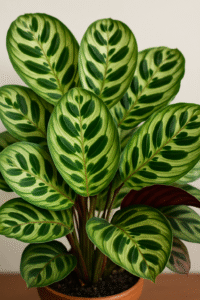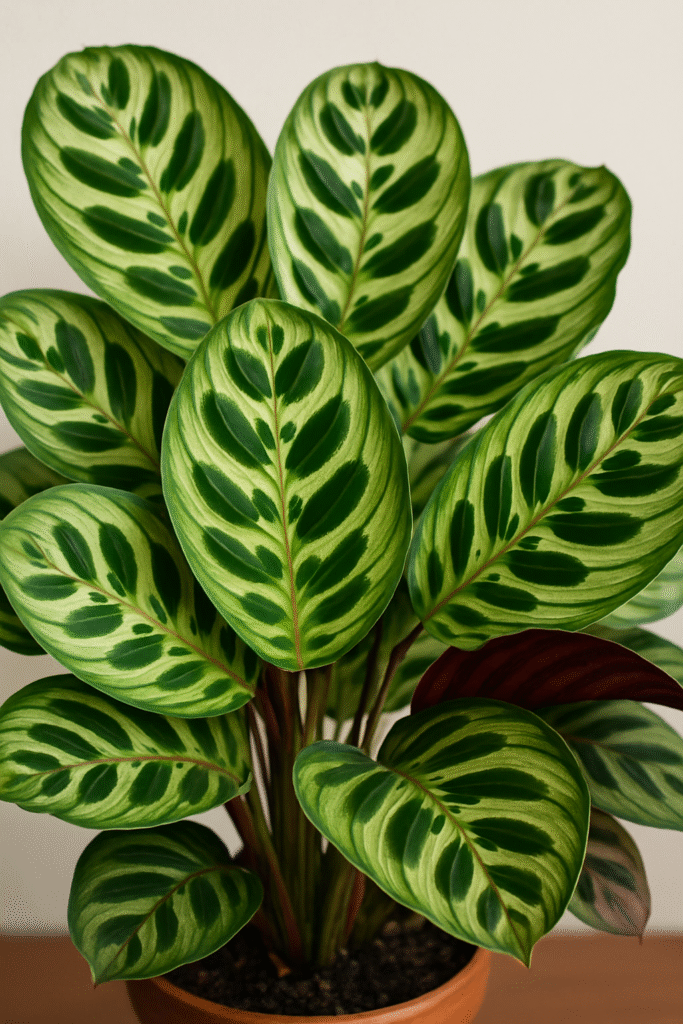The Peacock Plant, scientifically known as Calathea makoyana, is a striking tropical houseplant admired for its vibrant and intricately patterned leaves that resemble the feathers of a peacock. Native to Brazil’s lush rainforests, this ornamental plant is a popular choice for indoor spaces due to its unique beauty and moderate care requirements.
If you’re looking for an eye-catching foliage plant that adds a touch of exotic flair to your home, the Peacock Plant is a perfect pick. In this post, we’ll explore everything you need to know about Calathea makoyana—from its origin and features to care tips, propagation methods, and fun facts.
Origins and Characteristics of the Peacock Plant
Calathea makoyana is part of the Marantaceae family, which also includes other popular indoor plants like Maranta and Stromanthe. It thrives naturally in warm, humid forest floors where it receives filtered light and constant moisture.
Its standout feature is its oval-shaped leaves, marked with deep green patterns on a light green background, mimicking a peacock feather. The underside of each leaf is a beautiful shade of purplish-maroon, adding dramatic contrast. The foliage moves slightly throughout the day, a fascinating response to changes in light—hence the nickname “prayer plant.”
Why Choose a Peacock Plant?
Here are some compelling reasons to add a Peacock Plant to your indoor collection:
-
Striking foliage: No two leaves are exactly alike, making it a living piece of art.
-
Pet-safe: Unlike many other houseplants, it’s non-toxic to pets.
-
Air-purifying qualities: Helps improve air quality in enclosed spaces.
-
Perfect for indoor décor: Adds a tropical and artistic touch to any room.
Light Requirements
The Peacock Plant thrives in bright, indirect light. Avoid direct sunlight, which can cause the leaf colors to fade or even burn the delicate leaves. A north or east-facing window is ideal, or place it near a filtered light source with sheer curtains.
Watering Needs
This plant prefers consistently moist but not soggy soil. Water it when the top inch of soil feels dry, ideally using filtered or rainwater, as the Peacock Plant is sensitive to chemicals like chlorine and fluoride.
Too much water can lead to root rot, so ensure your pot has proper drainage holes.
Humidity and Temperature
As a tropical species, the Peacock Plant loves high humidity—ideally 60% or higher. If your indoor air is dry (especially in winter or with air conditioning), you can:
-
Use a humidifier.
-
Mist the leaves regularly.
-
Place the pot over a tray filled with pebbles and water (without the pot touching the water directly).
Maintain temperatures between 65°F and 80°F (18°C to 27°C) and avoid cold drafts or sudden temperature drops.
Best Soil and Fertilizer
Use a well-draining soil mix rich in organic matter. A good formula might include potting soil mixed with perlite, orchid bark, and peat moss or coco coir.
Fertilize every 2–4 weeks during spring and summer with a diluted, balanced liquid houseplant fertilizer (like 10-10-10). Reduce feeding in fall and winter when growth slows.
Pruning and Maintenance
Pruning is minimal—just remove any dead, yellow, or crispy leaves using clean, sharp scissors. This keeps your plant healthy and encourages new growth.
Repot every 1–2 years to refresh the soil and give roots more room, ideally during the growing season.
Propagation Tips
The best way to propagate a Peacock Plant is through division. When repotting, gently separate the root clump into two or more sections, ensuring each has a few leaves and healthy roots. Plant each section in a new pot with fresh soil and keep it moist until established.
Common Issues and How to Fix Them
Here are some problems you may encounter and their solutions:
-
Yellowing leaves: Usually caused by overwatering or poor drainage.
-
Brown leaf tips: Low humidity or mineral buildup in water.
-
Leaf curl or wilting: Underwatering or sudden cold drafts.
-
Spots or fading: Exposure to direct sunlight or water quality issues.
Consistently monitoring the plant’s environment helps prevent most issues.
Fun Facts About the Peacock Plant
-
The leaf movement is called nyctinasty, a reaction to light and darkness.
-
It’s often used in biophilic interior design, bringing nature into modern spaces.
-
Though still widely known as Calathea makoyana, recent taxonomic revisions have reclassified many “Calathea” species into the genus Goeppertia.
Final Thoughts
The Peacock Plant is a stunning indoor companion that rewards its caretaker with rich colors, rhythmic leaf movement, and a unique tropical presence. With a bit of attention to its humidity, water, and light needs, you’ll enjoy this living work of art for years.
And if you’re getting your hands into plant care, why not do it with comfort and style?

Claw Gardening Gloves for Planting, Garden Glove Claws for Women are a game changer when working with soil or repotting. These gloves combine functionality and protection, allowing you to dig and plant without tools while keeping your hands clean and safe.
Give your gardening routine a stylish upgrade!
Take your indoor gardening experience to the next level with tools that make planting easier and more enjoyable.

